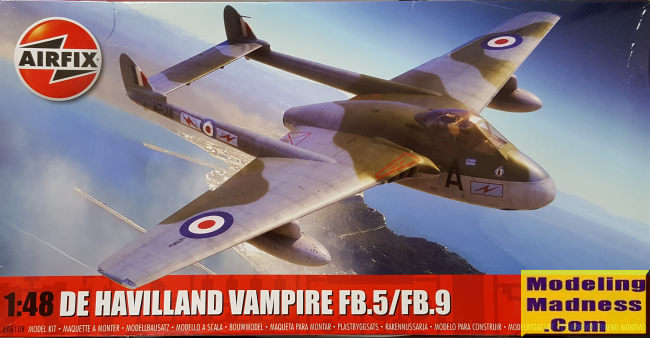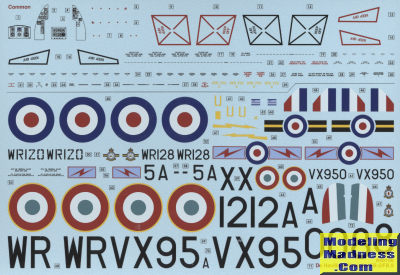
Airfix 1/48 Vampire FB.5/9
| KIT #: | A06108 |
| PRICE: | $46.00 delivered |
| DECALS: | Three options |
| REVIEWER: | Scott Van Aken |
| NOTES: | 2023 release |

| HISTORY |
The de Havilland Vampire is a British jet fighter which was developed and manufactured by the de Havilland Aircraft Company. It was the second jet fighter to be operated by the RAF, after the Gloster Meteor, and the first to be powered by a single jet engine.
Development of the Vampire as an experimental aircraft began in 1941 during the Second World War, to exploit the revolutionary innovation of jet propulsion. From the company's design studies, it was decided to use a single-engine, twin-boom aircraft, powered by the Halford H.1 turbojet (later produced as the Goblin). Aside from its propulsion system and twin-boom configuration, it was a relatively conventional aircraft. In May 1944 it was decided to produce the aircraft as an interceptor for the Royal Air Force (RAF). In 1946 the Vampire entered operational service with the RAF, only months after the war had ended.
The Vampire quickly proved to be effective and was adopted as a replacement of wartime piston-engined fighter aircraft. During its early service it accomplished several aviation firsts and achieved various records, such as being the first jet aircraft to cross the Atlantic Ocean. The Vampire remained in front-line RAF service until 1953 when its transfer began to secondary roles such as ground attack and pilot training, for which specialist variants were produced. The RAF retired the Vampire in 1966 when its final role of advanced trainer was filled by the Folland Gnat. The Royal Navy had also adapted the type as the Sea Vampire, a navalised variant suitable for operations from aircraft carriers. It was the service's first jet fighter.
The type was a huge export success with over 1,000 FB.5/6 aircraft being built overseas.
| THE KIT |
Last year, Airfix delighted many fans with the release of the Vampire F.3. This was a variant that wasn't as widely disseminated as later Vampire marques. It was a smart move on the part of Airfix as people who really wanted a 1/48 Vampire were able to get their fix. However, it was the later FB.5/9 version that was more widely used and that most of us who wanted a 1/48 Vampire were awaiting.
Now it is probably not too surprising that this kit shares the majority of sprues with the F.3 boxing. Basically the only major differences were the clipped wing tips of the FB.5/9 and the extened intake section for the FB.9 to fit the air conditioning package (such as it was). So let me provide a few highlights of this kit that might interest you.
The kit provides full intake trunking, though removing the join line will take some considerable effort. The engine compressor section includes the forward wall of the main landing gear. The rest of the gear well is built up of separate items. THe exhaust is the same with an upper and lower section that has a prominent seam. The final compressor stage includes the backwall of the flap/speedbrake section. A note on this. I looked at a LOT of period photos of Vampires on the ground. None had extended flaps. Some did have the speedbrake deployed so you might want to keep that in mind.
A nicely detailed cockpit is provided and though you are expected to install 17 grams of noseweight to keep it from tail-sitting, finding space for what is a fair amount of weight will be difficult. Airfix also has you build and attach the booms to the lower wing prior to attaching the upper wing/fuselage section. As mentioned, there are separate right intake pieces depending on if you are doing the FB.5 or FB.9. Separate ailerons, flaps, rudders, and elevator is provided. For the flaps, there are separate pieces for raised and lowered flaps.
 All of
the landing gear are well done and quite sturdy looking. You do have the option
of open or closed canopy as well. Airfix provides a seat with a harness molded
in and one without if you want to use the pilot figure. Another neat feature is
that for a wheels up model, the main gear wells are glued from the inside for a
positive fit. Oddly, I did not see any step that showed how to do the nose gear
closed. The other option is for the underwing fuel tanks.
All of
the landing gear are well done and quite sturdy looking. You do have the option
of open or closed canopy as well. Airfix provides a seat with a harness molded
in and one without if you want to use the pilot figure. Another neat feature is
that for a wheels up model, the main gear wells are glued from the inside for a
positive fit. Oddly, I did not see any step that showed how to do the nose gear
closed. The other option is for the underwing fuel tanks.
Airfix instructions are very nice showing the previous assembly in color in the current assembly step. Markings are for three planes. Two are FB.9s with one in high speed silver from 213 squadron with large black areas on the nose and tail. The other is the camouflaged box art plane from 502 Squadron. The lone FB.5 is a high speed silver French plane from EC 5. The decal sheet is nicely done and provides the usual stencils.
| CONCLUSIONS |
The 1/48 Vampire has been kitted before. The oldest and worst is the Hobbcraft kit, followed by the nice, but difficult to build Classic Airframes kit and the more recent Trumpeter offering. This looks to be the best of the lot in terms of fidelity as the Trumpeter kit has an issue on the rear fuselage in terms of a too-large exhaust. Probably the worst part of the kit is the super flimsy box which didn't do well when the seller shipped the kit in a bubble bag instead of using a proper shipping box.
| REFERENCES |
https://en.wikipedia.org/wiki/De_Havilland_Vampire
October 2023 Copyright ModelingMadness.com. All rights reserved. No
reproduction in part or in whole without express permission from the editor. If you would like your product reviewed fairly and
fairly quickly, please
contact
the editor or see other details in the
Note to
Contributors.